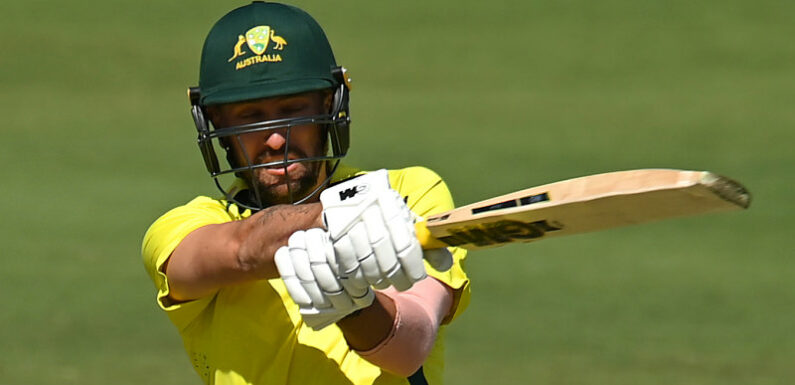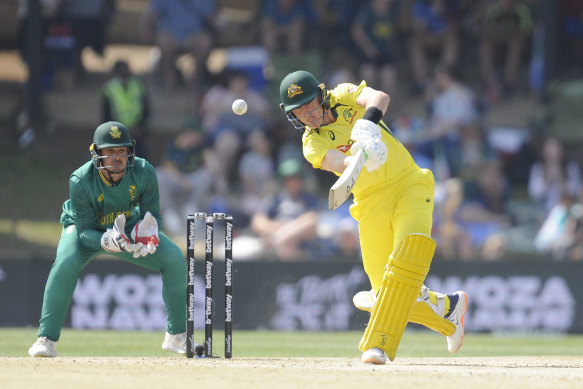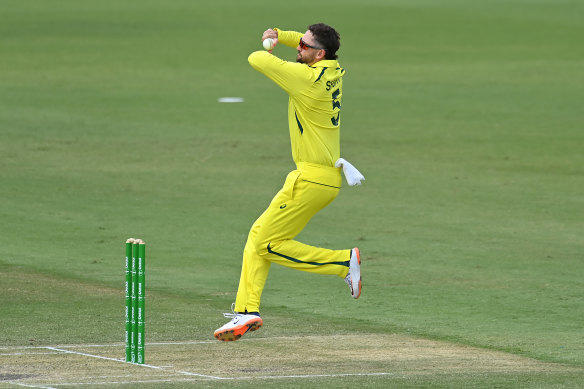
Save articles for later
Add articles to your saved list and come back to them any time.
Powerful, tall and a very useful off-spin bowler, Matt Short has a puncher’s chance of finding a way past Marnus Labuschagne to claim the 15th spot in Australia’s World Cup squad.
Should Travis Head be deemed too much of a risk to carry for the early part of the tournament, a likely scenario given the fractured hand that has kept him out of the India series, the selectors will have the obvious option of retaining Labuschagne.
Could Matt Short take the final spot in Australia’s ODI World Cup squad?Credit: Getty Images
In South Africa, Labuschagne demonstrated renewed focus in his ODI game as the series’ leading scorer. Allied to greater scoring intent, he fell in line with the desire of the team’s leaders for fast runs to put opposition attacks under pressure.
But in terms of like-for-like replacements for Head, who has been impactful by scoring quickly as well as consistently for the Australian ODI team, 27-year-old Short has both the destructive capacity with the bat and the finger spin to add to the mix.
Short has made his name via strong displays for the Adelaide Strikers in the Big Bash League over the past two years. They coincided with a move to the top of the order after making a request to coach Jason Gillespie for a chance.
But Short’s improving returns for Victoria at Sheffield Shield and limited-overs levels also indicate the sort of three-dimensional qualities that are vital in the 50-over format.
A Ballarat product who moved to Melbourne at the age of 18, Short has occasionally presented the sort of batting threat that Australia’s pace bowlers became acquainted with in England during the “Bazball” Ashes, using his height and reach to turn good length deliveries into hittable ones.
In the second half of the Shield last season, Short’s contributions included innings of 70 (69 balls) and 119 (135 balls) against South Australia, and 82 (95 balls) versus Western Australia, as well as a more sedate 104 from 196 balls against NSW. He also cracked 108 from 96 balls against Queensland in a one-day game.
Among a group of young players aspiring to take over from the generation of David Warner and Steve Smith, Short is one of the few with genuine capacity to change momentum in a game, whatever the format.
And where Labuschagne’s wrist spin bowling has trailed off after being a very valuable component of Australia’s Ashes defence in England in 2019 – partly because he has experimented with off-spin and seam bowling rather than perfecting his leg breaks – Short’s spin has been making gains with both red and white balls.
Marnus Labuschagne hits out against South Africa.Credit: Getty Images
Intriguingly, both Short and Labuschagne have been influenced by Greg Chappell in their earlier days. The former took to heart a lesson to think first of scoring boundaries before defending; the latter was advocated for at the selection table when he was perceived to be well back in the queue for Test team places in 2018.
There is no doubt that Australia’s current selectors value versatility. They have banked on the concept of a deep batting line-up stocked with all-rounders in their attempt to win the World Cup in India for the first time since Allan Border’s side did the trick in 1987.
Marcus Stoinis and Cameron Green, two key components of that plan, will be looking to demonstrate their run-making ability. Green, capable of hitting a long ball but also of playing at a measured tempo, has the capacity to moderate the middle overs alongside Smith. Averaging little more than 17 with the bat over the past two years, Stoinis simply needs a score.
Over a three-game series set to begin in Mohali on Friday night (AEST), the selectors will also have the chance to take a final look at Short, Labuschagne and Tanveer Sangha among others. The likes of Smith, Glenn Maxwell, Mitchell Starc and Pat Cummins will return to active duty after injuries.
Matt Short’s off-spin offers versatility.Credit: Getty Images
Despite all their firepower, Australia’s weaknesses in one-day games were made clear by the Proteas as South Africa surged from 0-2 down to win the white ball series 3-2, monstering the tourists’ death bowling and corralling the middle order.
By the team’s own admission, there was a sloppiness about the South Africa series that must be eradicated ahead of the cup proper.
India were beaten in a white-ball series earlier this year, but this close to a World Cup on home soil they will be extremely sharp, not least after winning the Asia Cup by razing Sri Lanka in the final in Colombo.
News, results and expert analysis from the weekend of sport sent every Monday. Sign up for our Sport newsletter.
Most Viewed in Sport
From our partners
Source: Read Full Article


